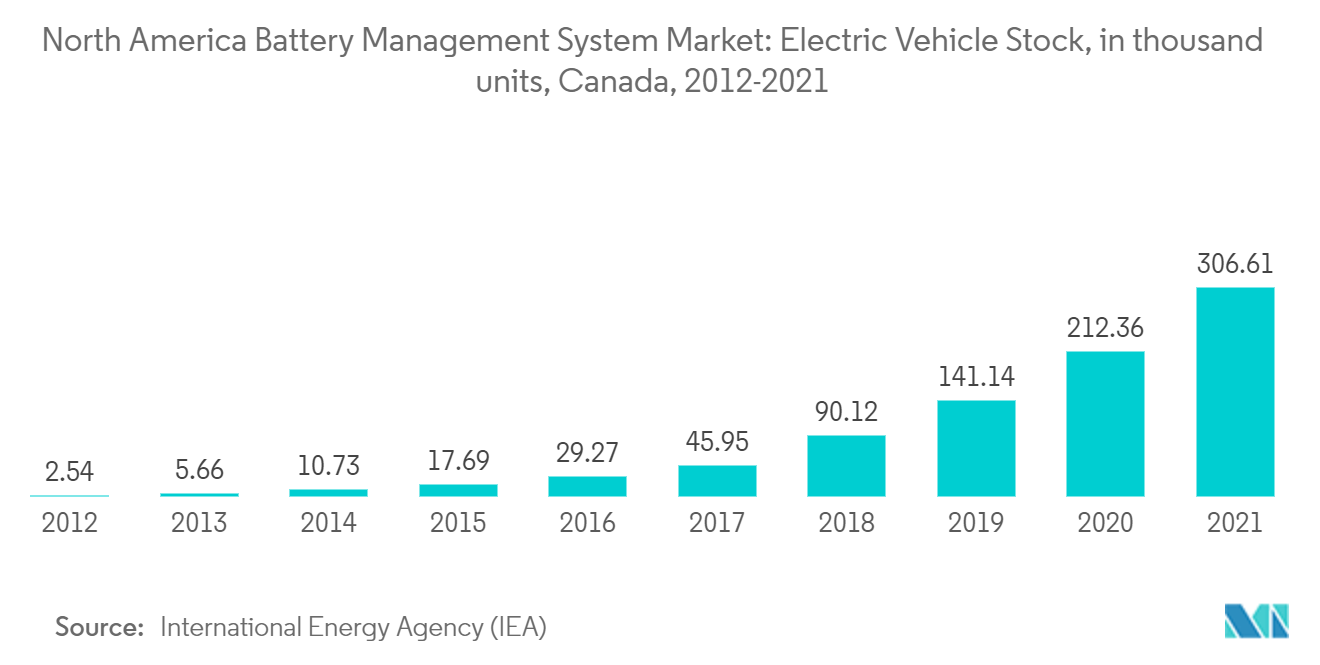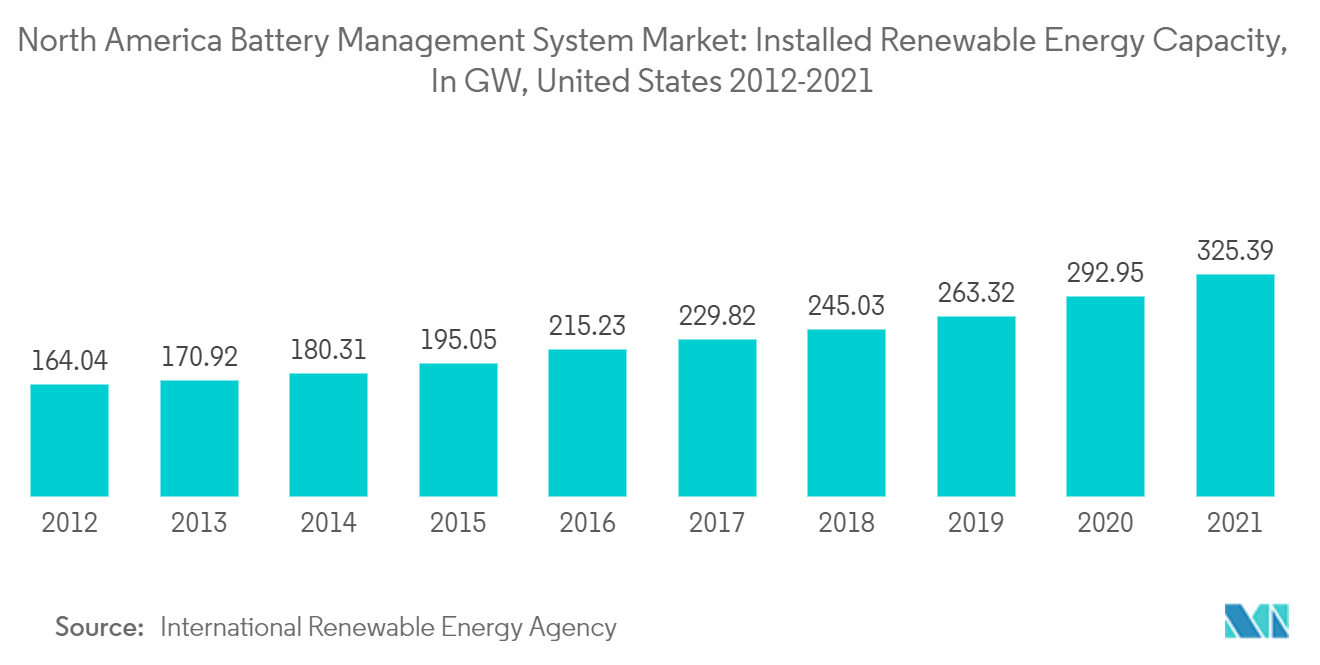Market Trends of North America Battery Management System Industry
This section covers the major market trends shaping the North America Battery Management System Market according to our research experts:
Transportation Segment Expected to Dominate the Market
- Vehicles with internal combustion engines (ICE) were the only types used earlier. However, technology has been shifting toward electric vehicles (EVs) due to growing environmental concerns. Therefore, due to these reasons, battery management systems do not have any market in the ICE sector.
- Lithium-ion batteries are primarily used in EVs as they provide high energy density, low self-discharge, less weight, and low maintenance. For ICE vehicles, the lead-based battery is being widely used and is expected to continue to be the only viable mass-market battery system for the foreseeable future. For use in SLI applications, lithium-ion batteries still require higher cost reductions for them to be considered a viable mass-market alternative to lead-based batteries.
- Lithium-ion battery systems propel plug-in hybrid and electric vehicles. Owing to their high energy density, fast recharge capability, and high discharge power, lithium-ion batteries are the only available technology capable of meeting OEM requirements for the vehicles driving range and charging time. The lead-based traction batteries are not competitive for use in full hybrid electric vehicles or electric vehicles because of their lower specific energy and higher weight.
- Mexico is witnessing rapid growth in its EV manufacturing market. In April 2022, construction started on an EV parts manufacturing facility in Ramos Arizpe in the state of Coahuila. The factory is jointly owned by LG Electronics and Canadian automotive supplier Magna International and is expected to produce motors, inverters, and other EV components.
- In addition, in April 2022, Link EV announced plans to invest nearly USD 265 million in a new EV production facility in Puebla. The company plans to start operations in H2 2022, and the plant is expected to consist of four production lines with a nominal capacity of 1,200 units initially. Such large-scale developments in the production of EVs are expected to create a demand for EV BMS in the country during the forecast period.
- Similar to the United States, the Canadian automobile industry is also undergoing a transition, with most auto producers pivoting their business toward electrification by setting up new plants or repurposing older plants to produce EVs.
- For instance, General Motors has invested nearly USD 1.5 billion at its Oshawa and CAMI assembly plants and plans to launch the country's first full-scale commercial electric vehicle production facility at the CAMI Assembly Plant in Ingersoll. In April 2022, the government of Canada announced an investment of nearly USD 205 million in GM motors to assist in the construction of these plants. The CAMI plant is expected to begin commercial operation by the end of 2022.
- According to the Energy Information Agency (EIA), as of 2021, Canada's EV stock was recorded at approximately 306.61 thousand units, up by nearly 44,38% from 2020 stock volumes.
- Hence, based on the factors mentioned above, the transportation segment is likely to dominate the battery management systems market during the forecast period.

United States is Expected to Dominate the Market
- The United States will be one of the largest global markets for energy storage systems and electric vehicles in 2021. Both the end-user segments utilize battery management systems (BMS) for the adequate performance of the battery system. Due to the high demand from these two massive end-user industries, the country is expected to be one of the forecast period's most prominent and fastest-growing markets for BMS systems.
- The United States has one of the world's most well-developed automotive sectors. As climate and environmental concerns are rising, most automakers in the country have prioritized the production of electric vehicles. Additionally, the United States government has focused on increasing its electric vehicle fleet to reduce fossil fuel dependence and emissions.
- According to the Energy Information Agency (EIA), as of 2021, United States' EV stock was approximately 2.06 million, up by nearly 16.1% from 2020 stock volumes, making it the second largest global EV market after China.
- As of 2021, the United States is one of the largest renewable energy markets globally, and over the period of 2012-2021, installed renewable energy capacity has grown from nearly 164.04 GW to 325.39 GW, a growth of almost 74%. According to the United States Energy Information Administration (EIA), it is expected that renewable generation share to increase from 20% in 2021 to 22% in 2022 and 24% in 2023. According to EIA forecasts, 7.6 GW of new wind capacity is expected to come online in 2022 and 4.3 GW in 2023, while for utility-solar, new capacity additions of 21.8 GW for 2022 and 24.1 GW for 2023 are expected, and small-scale solar is expected to grow by 4.4 GW per year in both 2022 and 2023.
- Due to this rapid rise in renewable generation, grid stability has become a major issue in countries with a high level of renewable integration in their grids. Nearly 66% of the United States' installed renewable energy capacity is from wind and solar, which are inherently variable energy sources. To store renewable energy generation during high generation periods and release it during peak demand, ESS systems are needed, while BMs dictate the efficiency and operation of these systems.
- The United States is expected to witness the development of massive battery farms, which are expected to provide utility-scale energy storage. These utility-scale systems are to be monitored and operated via sophisticated BMS, which is expected to allow bi-directional energy flow and battery optimization to improve battery life while maximizing efficiency and minimizing accidents.
- In June 2022, the NADBank (North American Development Bank) announced that it plans to provide a USD 5.7 million loan for the Zier Solar and Energy Storage Project near the town of Brackettville in Kinney County, Texas. The 160 MW solar PV project is co-located with an 80MWh battery energy storage system (BESS). Construction is expected to start in 2022, while the project is expected to be commissioned by Q3 2023.
- Therefore, the above-stated factors can be considered the major driving factors for battery management systems in the country, where the market is expected to grow during the forecast period.

